On my latest expedition, I was accompanied by my eldest ruin-hunter Ryan. We visited a number of sites, around Kildare that I have not been to in a few years. So to kick things off I thought that I would start with, in no particular order, the remains of the ecclesiastical site at Old Kilcullen which I first explored back in early 2012. It has played a big part in over 1500 years of Irish History. Its real Gaelic name was Cill Chuilinn or ‘Church of the Holly’. Once the site of an early fort, then an ecclesiastical settlement dating from the 5th century, followed by a walled town. This settlement gave its name to the surrounding lands for many years. Around 1319AD the urban center of the area was moved about 2km NE after a bridge was constructed to cross the River Liffey. This area is now known as either Kilcullen or Kilcullen Bridge, with our historical site being known as Old Kilcullen. The first monastic settlement here is believed to date back to approx 448AD and is said to have been connected to St. Patrick. It is unclear as to who ran this monastery but both St. Iserninus and St. Eoghan (Mactail) were both Bishops of the area. The Annals of the Four Masters or the Annála Ríoghachta Éireann, record the deaths of a number of its abbots from the late part of the 8th-century, along with a number of bishops whom where noted in the 10th and 11th-centuries. Like many other sites of its kind, Kilcullen was raided by Viking invaders on at least two separate occasions, firstly in 936AD and then 944AD. From the later raid by Amhlaibh and the foreigners (Norse of Dublin), it was reported that a large number of the local population were taken prisoner, presumably for the slave trade. The Annals of the time also mention a stone church in 1037AD and the burning of the Monastery in 1114. I could not see any visible sign of the original Monastery, but perhaps the curving boundaries in the surrounding fields may reflect the early Christian enclosure. The town was said to have a number of gates and roads during the Anglo-Norman era. There is also mention of a nearby Castle which would have been held by the FitzEustace family during the reign of Henry VIII. Sadly there are no surviving remains of the Castle or the original walled town.
There is room to park a couple of cars near the site enterance with a walk up a long lane to the ecclesiastical complex atop the hill. Once we parked up Ryan swapped his point & shoot camera for my HTC 1 smartphone to take his own pictures as the P&S was malfunctioning for some reason. After a brief explanation of the site Ryan was the first one through the gate and proceeded to run up the hill to get started. Situated within a walled graveyard on a sloped hill, Old Kilcullen contains a number of interesting features. Most noticeable is the badly damaged Round Tower, which still commands a visible presence over the surrounding area. There are also the remains of not one but two High crosses and a cross bass and finally the scant remains of a church. A 16th century grave slab which contained the effigy of an unknown Knight once stood in the medieval church here, but was moved to another church in Ballymore Eustace where it now resides in the graveyard. I wonder considering the family connection as Barons of Kilcullen and the family name being part of Ballymore Eustace, might the effigy of the Knight been one of the FitzEustace family? On a clear day there are stunning views with the Wicklow Mountain range to the east. The graveyard which is interestingly still in use today is surrounded by a stone wall and can be accessed via a gate and stile in the NW wall. There are many grave markers that are still legible and date from the 18th century to present, but there are also quite a number of unmarked stones which have been badly weathered or are so old that they may very well date back to the time of the early Christian monastery. The monastery was linked to St Maelruain’s monastery of Tallaght and adopted the practices of the Ceile De movement. It is quite nice to see such an old site so well cared for and there is plenty of evidence to suggest that the graveyard is still in use today.
The first feature you will notice upon entering the graveyard is the shaft of what must once have been a stunning High Cross in the NW section of the graveyard. Sadly the cross did not survive completely, what happened to the remainder of the cross is unknown, but it was said to be in a leaning state by 1862. After spending some years laying on the ground it was eventually raised and re-mounted. Also known as the North Cross, it consists of a highly decorated square shaft, 2 meters in height, made from granite, with a square base. Whilst the south face has been badly eroded over the years, with only a faint trace of interlace designs, the other three sides are in reasonably good condition. The North face contains three panels with a depiction of what I presume is David and a Lion, followed by an inter-lace design and finally what is believed to be a depiction of St. Mac Tail whom was a bishop here. He is shown striking another person with what looks to be an Adze, (a cutting tool that has a thin curved blade and that is usually used for shaping wood). Who is the victim shown in this panel? We can only speculate, perhaps it was an enemy or even a Viking, either way it looks like they may lose their head. This Mac Tail character was said to have died in 548AD as a result of the yellow plague which swept through the country at the time. The East face also has three panels which I can only assume represents the 12 Apostils’, with four human figures on each panel. And finally to the West face which depicts a number of Biblical references again on three separate panels. The first shows a horseman blowing on some kind of trumpet, which may have something to do with the story about Jericho. The second shown Samson killing the Lion, which is followed by a figure with a Donkey. I never thought of it at the time, but a great way of showing up faded stonework is to take a charcoal rubbing, using a simple sheet of thin paper such as greaseproof paper, which can be found in most kitchens and a piece of art charcoal or a thick wax crayon. I think going forward I shall include this equipment in my backpack for future visits, just in case.
The next item we find is the sad looking excuse for a Round Tower. Ryan quickly volunteered that ‘’this is where the monks hid when the bad Vikings used to attack and rob all their stuff’’. The Tower was believed to have been used as a Bell-Tower and a depository for valuables. It currently stands at a mere height of only 10 meters and was built using rough coursed Limestone blocks. The doorway is about 1.8 meters above the ground with a round head in the north side of the tower, blocked by an iron gate with some form of vegetation growing out through the bars. Only one, of the four windows which once existed remains. It can be seen on the south side of the tower at around the second floor level, it consists of a flat lintel design with granite jambs and a limestone sill. The tower is first mentioned in 1781 and said to have four windows, then a drawing by Francis Grose from 1782 shows a Tower with a full window in the west with a partial cornice above. During the 1798 rebellion the Battle of Kilcullen took place on this very site when over 300 rebel fighters entrenched themselves within the graveyard. It was during this battle that the tower was said to have sustained serious damage, so I can’t tell the original height of the tower or whether it had a conical or castellated roof. Perhaps it may have never been fully completed? As Grose’s drawing indicates, the tower may not much taller than it is now. As an obvious vantage point, the tower became involved in many battles during its life time, from being held by Parliamentary forces in 1641, then being taken by Royalists before being recaptured and eventually burned in 1641 by the Parliamentary forces.
The remains of two other High crosses can be found in the east and west parts of the graveyard. To the east we find the remains of another granite cross. Comprising of a tall rectangular shaft with undecorated panels surrounded by low rounded mouldings. This cross is set into a pyramidal base. It may have been in the early stages of decoration work but was never finished. In the west we find granite cross, this time with a square shaft and a rectangular base. Neither items show any sign of decoration. In the North East of the graveyard we find the faint remains of what once was a 13thcentury Romanesque Church. It was said to have retained its dedication to St. Mac Tail throughout the Middle Ages and was one of the churches confirmed to Glendalough by Pope Alexander III in 1179AD. It was later granted to the Augustinian order in Dublin where it remained for the rest of the middle ages. In 1584 during an episcopal visit the Nave was said to be ok but the Chancel was in a ruinous state. With its stunning views, tranquillity and fascinating history I would highly recommend visiting Old Kilcullen if you get an opportunity. You won’t be disappointed.
For these and more of my images, why not visit my Website or join me on Facebook or Twitter



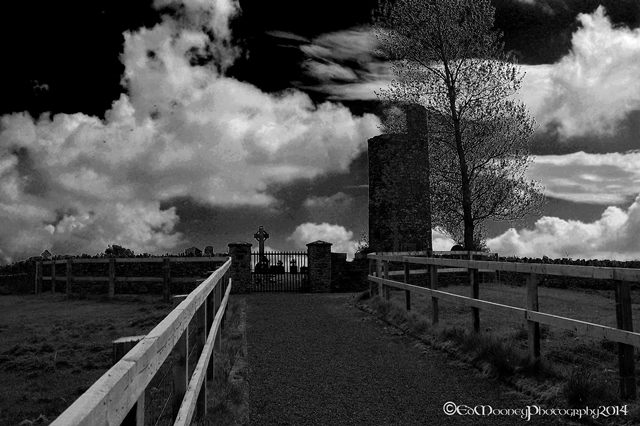
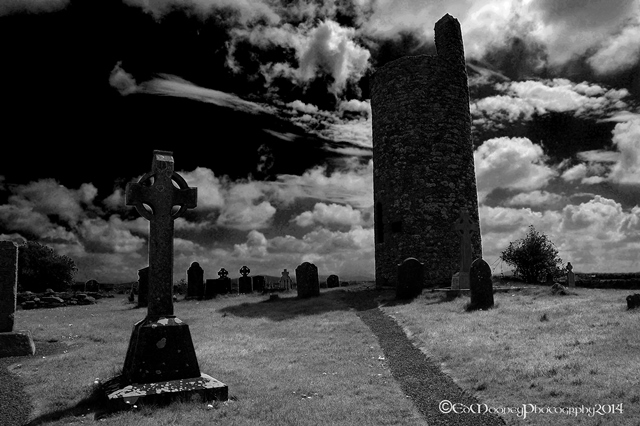




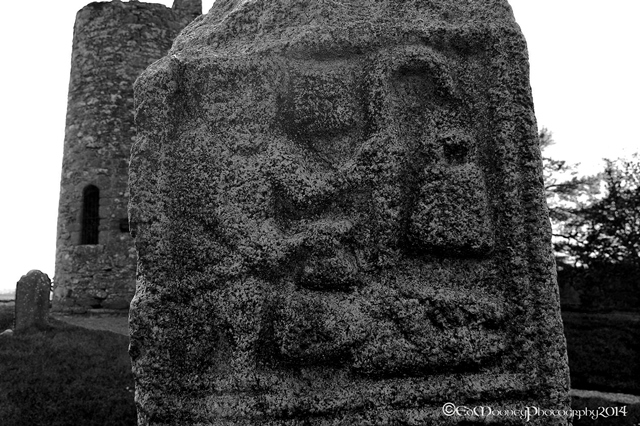

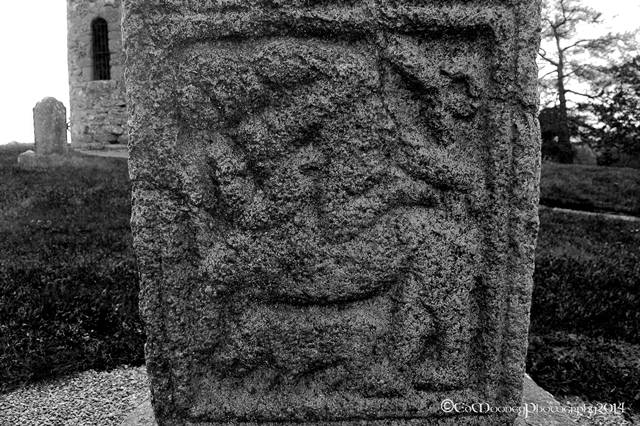





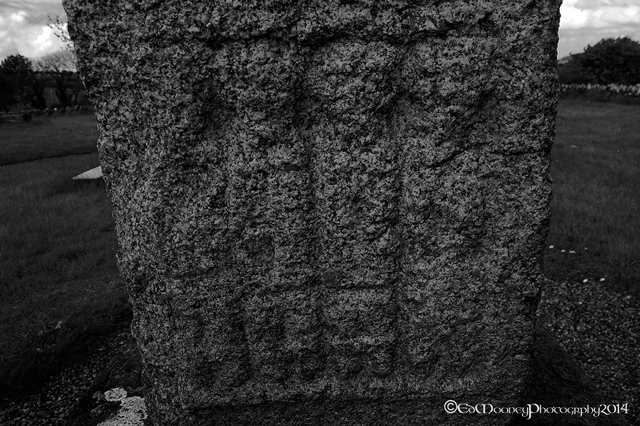









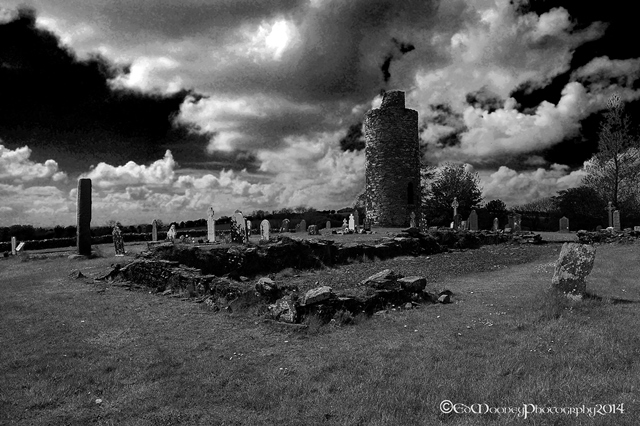




Lovely to see the detail of the carving, Ed. Thank you.
LikeLiked by 1 person
My pleasure Sue, glad you liked them 🙂
LikeLike
A beautiful place, such rich history.
LikeLiked by 1 person
Thank you John 🙂
LikeLike
Very interesting, Ed! There is a stone with similar carvings known as the Apostles’ Stone in Dunkeld Cathedral – I would imagine it dates from around the same time.
LikeLike
Yes I have seen similar carvings on other crosses around the country. It seems to be a popular theme at the time 🙂
LikeLike
Beautiful and I love those cloud formations!
LikeLike
Thank you, it was a gorgeous day 🙂
LikeLike
Looks like you both had a fun day of it. Thanks to the junior ruin hunter for providing scale to some of the shots 🙂
As always, an interesting visit with you and your searches.
LikeLike
We sure did, Thanks Robert, if we ever get the weather it will be Ava assisting the next trip:-)
LikeLike
Great images, Ed! Particularly like the 3rd one where the tree looks like fine lace against the clouds and sky. Those carvings may have been quite eroded but your B&W photography showed them up really well, I thought. I am always amazed that such ancient graveyards are still maintained so nicely and still used, even though they might be in the middle of nowhere with no church associated with them any more.
LikeLike
Thanks Ali, I guess the long history associated with the place has kept it alive, I come across so many similar sites that are overgrown and forgotten 😦
LikeLike
As always, fab pic’s. Ryan is right, “Those bad vikings.”
LikeLike
LOL, they were not that bad 🙂
LikeLike
I really enjoyed both the photos and the narrative. My favorites were the portcullis (well, it might be a portcullis- two photos down from the one with Ryan in color) and the second from the bottom- the clouds are prefect.
LikeLike
Thank you, the shot with as you said with the portcullis is just an iron gate, I can see where is could be seen as one though. It is actually the door into the round tower. Unfortunately it is secured with a very sturdy lock. Really glad you enjoyed these images, Old Kilcullen is a great place to visit 🙂
LikeLike
Excellent! Excellent! Excellent!
LikeLike
Thank you, much appreciated 🙂
LikeLike
Interesting, I was just watching a documentary about the Vikings the other day. Beautiful site, pity it wasn’t better preserved and that the Vikings raided it in the first place.
LikeLike
Nice moody shots. I do love a good church graveyard 🙂
LikeLike
Dont we all Stevie, there is just something fascinating about them 🙂
LikeLike
Ed, great work. Nice shot of your apprentice! Does he also carry a camera? I really appreciate that you include the etymology of the place names: “Its real Gaelic name was Cill Chuilinn or ‘Church of the Holly’.” Names tell a story, and I love to see how names travel and change through history. Thanks for taking the time to provide this detail. Do you speak Gaelic?
LikeLike
Thanks Cheryl, Ryan is normally equipped with one of my point & shoot camera’s. but due to ‘ahem’ some technical difficulties he had to revert to my HTC 1 smartphone for the day.
Place names can be very interesting as they can tell you alot about a place even before you visit.once you know what to look out for. Yes I do speak Gaelic, sadly not as much as I would like too. Although Ryan is learning the language in school and is showing a keen interest, which is great. 🙂
LikeLike
A beautiful place !
LikeLike
For sure, I just love finding these places 🙂
LikeLike
Spectacular shots, a really interesting history and some great skies in those shots.
Cheers
MTM
LikeLike
Its easy when you have a great place to work with 🙂
LikeLike
I can see I’m going to have to make a trip across the ocean. We having nothing old in Canadaland. lol
LikeLike
I think you should too 🙂 Surley there should be some native structures around. I know there are some in the US?
LikeLike
Well, there’s old… and then there’s ancient. 🙂
LikeLike
True, all interesting in their own right 🙂
LikeLike
Pingback: Return to Fontstown | EdMooneyPhotography
Pingback: Uachtar Ard | Ed Mooney Photography